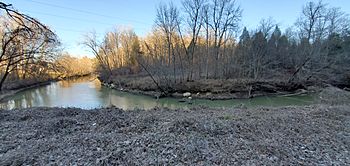Poplar Creek (Tennessee) facts for kids
Quick facts for kids Poplar Creek |
|
|---|---|
 |
|
| Country | United States |
| State | Tennessee |
| Physical characteristics | |
| Main source | 820 ft (250 m) |
| River mouth | Clinch River |
| Basin features | |
| Basin size | 82 sq mi (210 km2) |
Poplar Creek is a stream located in Anderson and Roane counties in East Tennessee. It's like a smaller river that flows into a bigger one. Poplar Creek is a tributary of the Clinch River. This means it's one of the smaller streams that feeds water into the Clinch River.
The creek's water comes from a large area called a watershed. Poplar Creek's watershed covers more than 82 square miles (212 square kilometers). All the rain and snow that falls in this area eventually flows into Poplar Creek. The creek then joins the Clinch River near a historic place once known as the K-25 site. Its biggest branch, called East Fork Poplar Creek, also flows into it nearby.
What is Poplar Creek?
Poplar Creek is a natural waterway in the eastern part of Tennessee. It starts high up in the hills, about 820 feet (250 meters) above sea level. As it flows, it collects water from many smaller streams and springs. Eventually, it reaches the Clinch River, which is a much larger river.
Where is Poplar Creek Located?
Poplar Creek flows through two counties in Tennessee: Anderson County and Roane County. These counties are in a region known as East Tennessee. The creek's path takes it through different landscapes, from forests to more developed areas. Its journey ends when it merges with the Clinch River.
The Importance of Watersheds
Every creek and river has a watershed. A watershed is like a giant funnel. It's an area of land where all the water drains into a single body of water. For Poplar Creek, its watershed includes all the land where rain and snowmelt flow into the creek.
- Water Collection: Watersheds collect water from rain and snow. This water then flows into streams and rivers.
- Natural Habitats: Watersheds provide homes for many plants and animals. The health of the watershed affects the health of the creek.
- Human Use: People also rely on healthy watersheds for drinking water, farming, and recreation.
Wildlife and Nature Around the Creek
Poplar Creek and its surrounding areas are home to various types of wildlife. The water itself supports fish, insects, and other aquatic creatures. Along the banks, you might find different kinds of plants, trees, and animals.
- Fish: Many small fish species live in the creek. They need clean water to survive.
- Insects: Aquatic insects are a food source for fish and birds.
- Birds: Birds often visit the creek to find food or drink water.
- Mammals: Small mammals like raccoons or deer might live near the creek.
Keeping the creek clean is important for all these living things.
The K-25 Site and Poplar Creek
Poplar Creek flows near a place that was once very important in American history. This place was called the K-25 site. During World War II, the K-25 site was part of a secret project. This project was about developing new scientific technologies.
The site was a large industrial complex. It played a big role in scientific advancements during that time. Today, the K-25 site is no longer active in the same way. It is now part of the Oak Ridge National Laboratory area. The creek's closeness to this historic site shows how natural features can be near important human developments.
Protecting Poplar Creek
Keeping Poplar Creek healthy is important for everyone. Clean water is vital for wildlife, plants, and people. There are many ways to help protect creeks and rivers.
- Reduce Pollution: Don't litter or pour harmful chemicals into drains. These can end up in the creek.
- Conserve Water: Using less water at home helps keep more water in the creek.
- Support Conservation: Learn about local efforts to protect waterways. You can even join groups that help clean up creeks.
By understanding and protecting our local waterways like Poplar Creek, we help keep our environment healthy for future generations.

